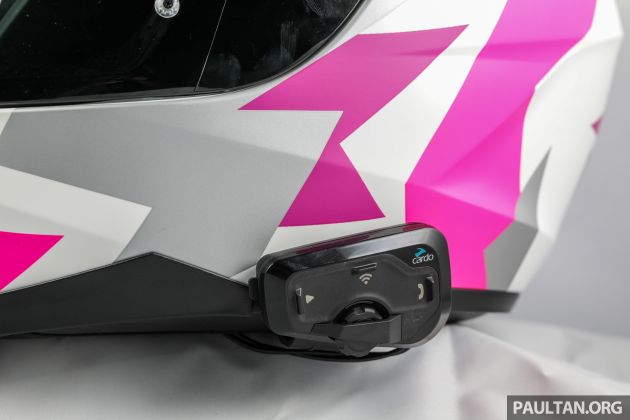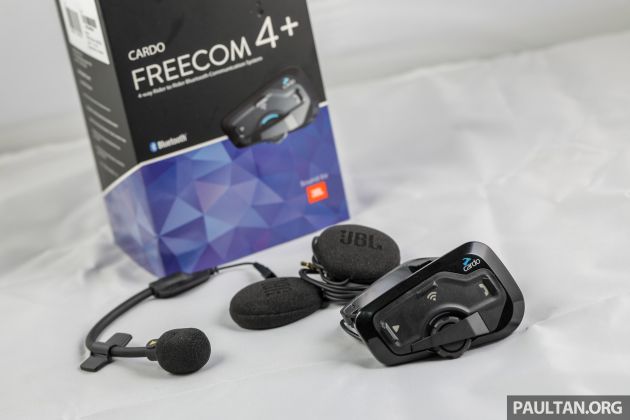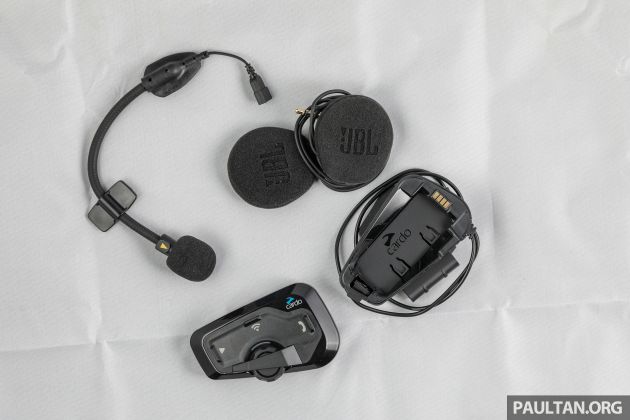Motorcycling is a solitary sport, with every rider alone inside his helmet. Sometimes, though, there is a need to communicate with other riders and in the bad old days, this took the form of walkie-talkies and FM radios, which is where in modern times the Cardo Freedom 4+, priced at RM1,188, comes in.
Using Bluetooth, the Freecom 4+ sits just below the top-of-the-range Cardo Packtalk and works with any Bluetooth compatible device, including communicators from other brands as well as smart phones. Coming in a smart brick-sized box, the Freecom 4+ unboxing reveals the unit itself, the helmet mount, 40 mm JBL speakers, two microphone options and various velcro pads.
Installing the Freecom 4+, we opted for the clip mount since it is intended our review unit will be transferred within the helmets in the author’s collection. Slipping the clip into the helmet shell is easy, if a little tight and care has to be taken to slide the clip into the EPS foam and shell.
If you’re concerned about the finish of your helmet, either put on a little duct tape where the mount will rest against the helmet shell or use a lid you don’t mind scratching up. Installing the speakers into the ear cups will necessitate pulling out the padding and seeing if there is a recess in the EPS foam to locate the speakers.
This might be missing in pure race helmets, so check before you buy. In any case, we installed the Freecom 4+ in three specific helmets – Shark Spartan, Shark Explor-R and HJC C70 – and faced no issues doing so, with the IP67 waterproof rating giving further peace of mind.
For the microphone, we opted for the hybrid microphone which is more properly used for open face and modular helmets for ease of installation and transfer between helmets. If you choose to install the corded mic, a velcro pad will be needed to hold the microphone unit in place on the inside of the helmet chin bar.
Setting up the Freecom 4+, after charging it up, was a breeze. Switching it on a two-button press affair, after which the blue LED comes on. Pairing with Bluetooth devices is easy, just set your device to “visible” mode and scan for the Freecom 4+, selecting it for pairing when it appears.
Downloading the Cardo Connect app – 18.79 Mb on Google Play – makes setting up the Freecom 4+ easier and allows for full control via the rider’s smartphone. With everything buttoned up, we took the Freecom 4+ out for a first ride. 2,400 km worth across southern Thailand with Triumph Malaysia on a Tiger 800 XRX.
The Freecom 4+ is a slim design, measuring some 20 mm in thickness with a rotary dial and three buttons giving the rider control over almost all functions including pairing and unpairing. In practical use, we found the Freecom 4+ unintrusive, with barely any added wind noise or buffeting.
Activating the Freecom 4+ is by one of two methods, the first using buttons, the other with voice command. This takes the form of the rider saying “hey Cardo,” followed by the command to play music, answer calls or access the smartphone – Siri for Apple iPhones, Google for Android devices.
In operation, once your Freecom 4+ is paired with your smartphone, connection takes place automatically but this option can be disabled if you so choose. Sound quality from the speakers is crystal clear at highway speeds, with the caveat you are using a full face helmet and the visor is closed.
This will vary tremendously depending on the type of helmet you are wearing, visor or lack thereof and your road speed. Listening to music streaming via the smartphone, the clarity was acceptable and somewhat better than some of the previous helmet comms devices we have used, especially with the Freecom 4+ automatic volume level function.
While we did not use the Freecom 4+ to make calls – the reason we ride is to be alone, after all – we did have to receive several calls during our time in the saddle. When a call comes in, audio is immediately muted and the call can be answered by pressing a button.
Connection between comms devices is easy after pairing is done, and the Freecom 4+ allows for four-way communication between Cardo units, letting riders and passengers talk as a group. We did not get a chance to check for distance between units before the signal drops but were informed by the Cardo tech crew it is about 1.2-kilometres with signal quality dependant on physical obstructions such as hills and corners.
Battery life was very good in our estimation, with Cardo claiming a 13-hour talk and standby time and the unit allows charging on the go. In practice, we only charged our Freecom 4+ once during the five day trip, and only because it was in preparation for a 600 km riding day.
Related Cars for Sale on
Source: Read Full Article












